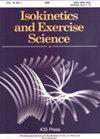局部振动和视觉反馈对日本健康成年人盆底肌训练的急性影响:一项交叉研究
IF 0.6
4区 医学
Q4 ENGINEERING, BIOMEDICAL
引用次数: 0
摘要
背景:那些接受盆底肌肉训练(PFMT)的人经常经历感知困难;因此,应该设计一种更简单的PFMT方法。目的:确定将PFMT与品牌衬垫(非原型)提供的振动刺激或视觉反馈相结合在增加PFM肌肉活动方面的有效性。由于PFM不涉及大的关节运动,肌肉活动是一个合适的指标。方法:本研究纳入20名健康成年人。所有参与者在三种条件下使用品牌垫子进行PFMT:振动刺激、视觉反馈和对照。这三个条件都是单独提供的。会阴中线两点的PFM活动记录为使用PFM肌电图测量的均方根,每种情况测量两次。通过计算PFM在PFMT前和后条件下的最大自主收缩来获得肌肉活动率。结果:在振动刺激和视觉反馈条件下,PFMT后PFM活性和肌肉活性比率均显著升高(分别p<0.01和p<0.01)。结论:PFMT伴随振动刺激或视觉反馈可以立即提高PFM肌肉的活性。我们相信,这项研究通过提出更合适的PFMT方法,有助于提高PFMT的效率。本文章由计算机程序翻译,如有差异,请以英文原文为准。
Acute effects of local vibration and visual feedback on the pelvic floor muscle training in Japanese healthy adults: A cross-over study
BACKGROUND: Those undergoing pelvic floor muscle training (PFMT) often experience difficulty in perception; therefore, an easier PFMT method should be devised. OBJECTIVE: To determine the effectiveness of combining PFMT with either vibration stimulation or visual feedback provided by a branded cushion (not a prototype) in increasing PFM muscle activity. Since PFM does not involve large joint movements, muscle activity was a suitable indicator. METHODS: Twenty healthy adults were included in this study. All participants performed PFMT under three conditions using a branded cushion: vibration stimulation, visual feedback, and a control. All three conditions were provided separately. PFM activity of the midline of the perineum at two points was recorded as the root mean square measured using PFM electromyography, measured twice for each condition. Muscle activity ratio was obtained by calculating maximum voluntary contraction of PFM in pre- and post-PFMT conditions. RESULTS: PFM activity and muscle activity ratio were both significantly higher following PFMT under vibration stimulation and visual feedback conditions (p< 0.01, p< 0.01, respectively). CONCLUSIONS: PFMT accompanied by vibration stimulation or visual feedback could immediately raise PFM muscle activity. We believe this study contributes to improving PFMT efficiency by suggesting more suitable PFMT methods.
求助全文
通过发布文献求助,成功后即可免费获取论文全文。
去求助
来源期刊

Isokinetics and Exercise Science
医学-工程:生物医学
CiteScore
1.20
自引率
14.30%
发文量
37
审稿时长
>12 weeks
期刊介绍:
Isokinetics and Exercise Science (IES) is an international journal devoted to the study of theoretical and applied aspects of human muscle performance. Since isokinetic dynamometry constitutes the major tool in this area, the journal takes a particular interest in exploring the considerable potential of this technology.
IES publishes studies associated with the methodology of muscle performance especially with respect to the issues of reproducibility and validity of testing, description of normal and pathological mechanical parameters which are derivable from muscle testing, applications in basic research topics such as motor learning paradigms and electromyography. The journal also publishes studies on applications in clinical settings and technical aspects of the various measurement systems employed in human muscle performance research.
The journal welcomes submissions in the form of research papers, reviews, case studies and technical reports from professionals in the fields of sports medicine, orthopaedic and neurological rehabilitation and exercise physiology.
 求助内容:
求助内容: 应助结果提醒方式:
应助结果提醒方式:


